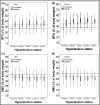Associations of body fat and skeletal muscle with hypertension
- PMID: 30525280
- PMCID: PMC8030364
- DOI: 10.1111/jch.13456
Associations of body fat and skeletal muscle with hypertension
Abstract
Hypertension is known to be associated with obesity, while its relationship to skeletal muscle, SM (SM; a marker of general health and body function), remains uncertain. We analyzed population-based data of 22 591 men (mean age: 51.6 ± 16.9 years) and 27 845 nonpregnant women (50.6 ± 16.9 years) from Scottish Health Surveys (2003, 2008-2011) and Health Surveys for England (2003-2006, 2008-2013) including 2595 non-insulin- and 536 insulin-treated diabetic patients. Compared with normotensive individuals (no hypertension history with normal systolic [SBP < 140 mm Hg] and diastolic blood pressure [DBP < 90 mm Hg]), percent body fat (BF%) was significantly higher and percent SM lower (P < 0.001) in undetected (no hypertension history with raised SBP ≥ 140 and/or DBP ≥ 90 mm Hg), controlled (hypertension history with normal BP), uncontrolled (hypertension history with raised BP), and untreated hypertension. The prevalences of hypertension within BF% quintiles were 11.8%, 24.8%, 41.4%, 56.8%, and 71.6% and SM% quintiles were 67.5%, 53.3%, 39.5%, 27.4%, and 18.5%. Compared to referent groups (lowest BF% quintile or highest SM% quintile), odds ratio (age, sex, smoking, ethnicity, country, survey year, and diabetes adjusted) for having all types of hypertension in the highest BF% quintile was 5.5 (95% confidence interval = 5.0-5.9) and lowest SM% quintile was 2.3 (2.2-2.5). Compared with those without diabetes, individuals with diabetes had a 2.3-fold-2.6-fold greater risk of hypertension, independent of confounding factors and BF% or SM%. The associations of hypertension with BF% were higher than those with body mass index (BMI). In conclusion, both BF and SM should be considered when analyzing results from health surveys, rather than relying on BMI which does not discriminate between the two.
Keywords: aging; blood pressure; diabetes; health surveys; obesity.
©2018 Wiley Periodicals, Inc.
Conflict of interest statement
The authors declare no relevant or conflicting interests.
Figures



Comment in
-
Diabetes, body fat, skeletal muscle, and hypertension: The ominous chiasmus?J Clin Hypertens (Greenwich). 2019 Feb;21(2):239-242. doi: 10.1111/jch.13453. Epub 2018 Dec 7. J Clin Hypertens (Greenwich). 2019. PMID: 30525276 Free PMC article. No abstract available.
-
Relationship between lean body mass indices, physical activity, and systolic BP: Analysis of 1999-2006 NHANES data.J Clin Hypertens (Greenwich). 2019 May;21(5):692-693. doi: 10.1111/jch.13516. Epub 2019 Mar 20. J Clin Hypertens (Greenwich). 2019. PMID: 30892817 Free PMC article. No abstract available.
References
-
- Baumgartner RN, Wayne SJ, Waters DL, Janssen I, Gallagher D, Morley JE. Sarcopenic obesity predicts instrumental activities of daily living disability in the elderly. Obesity. 2004;12:1995‐2004. - PubMed
-
- Zamboni M, Mazzali G, Fantin F, Rossi A, Di Francesco V. Sarcopenic obesity: a new category of obesity in the elderly. Nutr Metab Cardiovasc Dis. 2008;18:388‐395. - PubMed
-
- Sergi G, De Rui M, Sarti S, Manzato E. Polypharmacy in the elderly: can comprehensive geriatric assessment reduce inappropriate medication use? Drugs Aging. 2011;28:509‐518. - PubMed
-
- Yoon SS, Fryar CD, Carroll MD. Hypertension prevalence and control among adults: United States, 2011–2014. US Department of Health and Human Services, Centers for Disease Control and Prevention, National Center for Health Statistics; 2015.
MeSH terms
LinkOut - more resources
Full Text Sources
Medical
Miscellaneous

